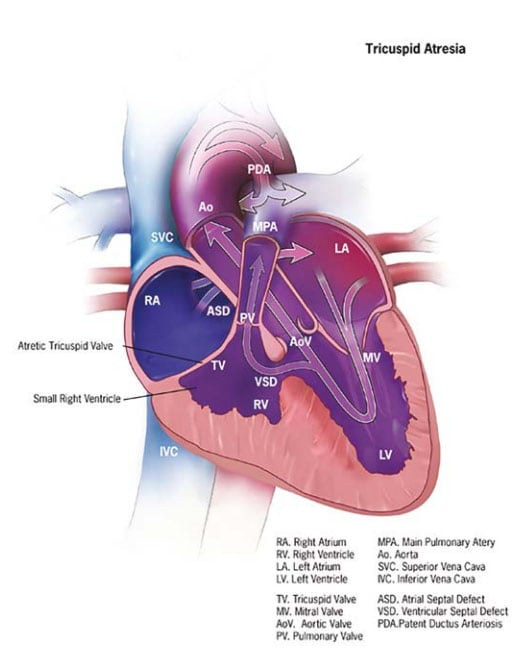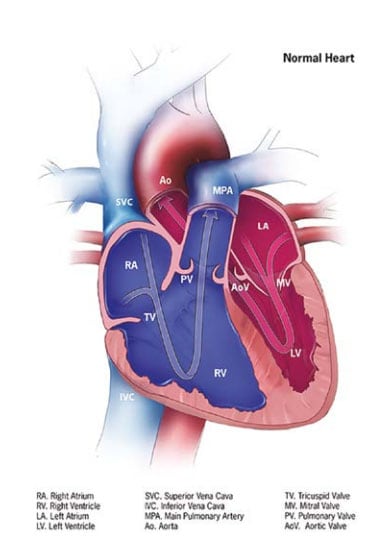Tricuspid Valve Atresia
Tricuspid valve atresia is a structural heart defect characterized anatomically by a complete agenesis (failure of formation) of the tricuspid valve, leading to absence of a direct communication and blood flow from the right atrium to the right ventricle. Having an atrial septal defect is crucial for survival (see Fig. 18, left panel), but blood mixing causes significant cyanosis.
Fig. 18. Tricuspid valve atresia


- Atretic tricuspid valve.
- Presence or absence of ventricular septal defect, important to note.
- Frequent occurrence of pulmonary valve stenosis/atresia, especially if ventricular septum is intact.
- Frequent occurrence in the context of complex heart anomalies (e.g. heterotaxy, single ventricle).
- Associated at times with extracardiac anomalies and genetic syndromes, especially deletion 22q11.
Diagnosis
Prenatal. Tricuspid valve atresia can be readily suspected prenatally but can be misdiagnosed and should be confirmed postnatally.
Postnatal. The common clinical presentation in the newborn is cyanosis. Echocardiography has largely superseded other imaging techniques, although these have a role (e.g. catheterization to assess right ventricular pressures and resistance). Newborn screening via pulse oximetry – which is based on the detection of low blood oxygen saturation – is expected to detect most cases of tricuspid atresia.
Clinical and epidemiologic notes
Infants can deteriorate quickly, especially if the atrial septal defect is small or when the ductus closes.
- The common clinical presentation in the newborn is cyanosis.
- Pulse oximetry can identify low blood oxygen saturation and can identify cases earlier.
- Look for extracardiac anomalies (e.g. cleft palate, internal anomalies) and genetic conditions, especially deletion 22q11.
- Note additional cardiac findings – tricuspid atresia can also occur in the context of complex cardiovascular anomalies; for example, with heterotaxy and single ventricle (double inlet left ventricle).
- Look for extracardiac anomalies – tricuspid atresia can be associated with deletion 22q11 (5–10%), common trisomies, and other rarer conditions.
Checklist for high-quality reporting
| Tricuspid Atresia – Documentation Checklist |
Describe in detail the clinical and echocardiographic findings:
Look for and document extracardiac birth defects, such as deletion 22q11. Report whether specialty consultation(s) were done, such as whether the diagnosis was made by a paediatric cardiologist, and whether the patient was seen by a geneticist. Report any genetic testing and results (e.g. chromosomal studies, genomic microarray, etc.). |